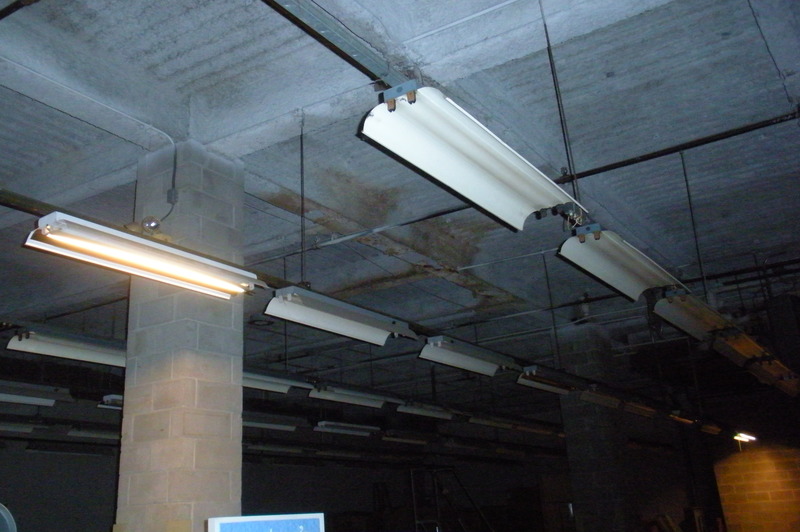One way among the many solutions of how to prevent mold after ceiling leak is drying the wet surface immediately. Apart from that, we will talk about two more below, so read until the end!

What Are The Causes Of Ceiling Leaks?
We know by now that water damage ultimately leads to mold growth. For this article, we’ll specifically talk about ceiling leaks and mold contamination.
Before anything else, let’s talk about the causes of ceiling leaks.
Roof damage
The leading cause of ceiling leaks is roof damage. Your roof is at the forefront of your house’s protection, shielding you from the elements.
Due to this, it will naturally need repairs after some time.
However, if you miss doing roof repairs, then it will lead to leaks. These roof leaks would eventually drip down to your ceilings.
Gutter problems
Gutters direct water away from your home. However, if it isn’t cleaned as often as it should, it gets clogged.
Clogged gutters lead to troubled water flows. Also, the weight of debris in the gutter may cause it to fall.
It may even push the water back to your roof’s shingles, causing ceiling leaks. Gutters only need to be cleaned twice a year, maybe more depending on the amount of debris.
How To Prevent Ceiling Leaks
As mentioned above, roof and gutter issues are the two leading causes of ceiling leaks. Hence, to prevent leaks from happening you have to maintain them.
1. Roof inspection
First, do a roof inspection after foul weather. That is if your area has recently been struck by storms, then inspect your roof for damage.
Specifically, look into loose or missing shingles, exposed surfaces, or cracks. You should also check the state of your roof vents.
A related roof inspection is looking into the plumbing vents. Plumbing vents can get damaged and worn off as well.
Look into their seals and gaskets to ensure they are still in working condition. Another thing you have to check is the functionality of your roof’s waterproofing membrane after a heavy storm.
2. Gutter inspection
Gutters play an active part in your home’s resistance to leaks. However, it is prone to debris which interrupts its water flow since it is located outside.
Clear out your gutters now and then to prevent them from clogging. Also, ensure that it is lined up nicely along your roof to avoid it leading to leaks as well.
How do ceiling leaks lead to mold growth?
It only takes 24 to 48 hours for mold to grow after water damage. Unattended water damage from your roof or gutter will trickle down to your ceiling.
The leaks would then provide a rich environment for mold to grow. Although, of course, it will be difficult to detect it at first.
Here is an article that may guide you in detecting black mold. Black mold is a common type of mold that grows in households, and familiarizing yourself with it will help you in the long run.
Ways of preventing mold growth after ceiling leaks
Mold needs four conditions for it to grow. It needs food, an adequate temperature, oxygen, and moisture.
It is not challenging to tick off the temperature and oxygen conditions indoors. Moreover, molds can easily find food sources behind the drywall.
Moisture is the final condition that needs to be met, and it happens when there is water damage. In this case, the water damage is due to ceiling leaks.
Since it takes more or less two days before your ceiling is mold-contaminated, you have to act fast upon identifying water damage. Here is an article that may help you detect water damage on wood.
To prevent mold growth after water damage, you have to dry the wet areas immediately. Better yet, address the root cause of the problem, so it would not resurface.
Detecting water damage is also crucial. Hence, you have to familiarize yourself with the warning signs even after drying and cleaning the area.
Inspect your roof and gutters like how was mentioned above. If there are damaged materials, remove and replace them immediately.
Handling all of this may be too much for you. If so, opt to call a professional instead of doing it on your own.
Steps in removing mold growth due to ceiling leaks
Step #1. Assess the damage and see which parts of your ceiling have been compromised by mold. If it is a small area, then prepare the needed materials to remove the mold.
Step #2. For the ceiling, you can use a mold stain remover. Do not forget to use protective gear while performing the mold removal process.
Step #3. If the mold has spread extensively it is too challenging for you, then calling a mold expert would help.
Conclusion
The difficulty of the mold removal process may depend on the extent of the damage. However, knowing how to prevent mold after ceiling leak is a better skill to have.
